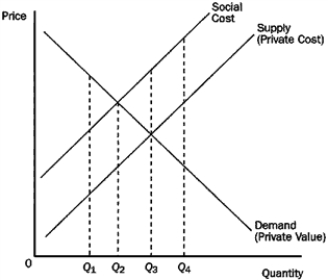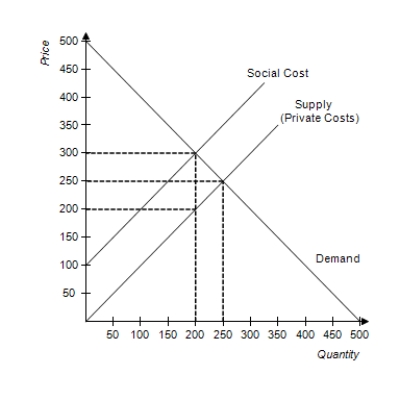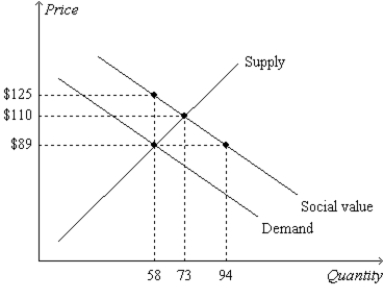A) Prices are set by supply and demand.
B) Allowing firms to trade their permits reduces the total quantity of pollution beyond the initial allocation.
C) Real-world markets for pollution permits include sulfur dioxide and carbon.
D) Firms for whom pollution reduction is very expensive are willing to pay more for permits than firms for whom pollution reduction is less expensive.
F) C) and D)
Correct Answer

verified
Correct Answer
verified
Multiple Choice
Dick owns a dog whose barking annoys Dick's neighbor Jane. Dick receives personal benefit from owning the dog, and Jane bears a cost of Dick's ownership of the dog. Assuming Jane has the legal right to peace and quiet, which of the following statements is correct?
A) If Dick's benefit exceeds Jane's cost, government intervention is necessary.
B) Dick will pay to keep his dog if his benefit exceeds Jane's cost.
C) If Jane's cost exceeds Dick's benefit, Dick will pay Jane to keep his dog.
D) If Jane has the legal right to peace and quiet, no further transactions will be mutually beneficial.
F) All of the above
Correct Answer

verified
Correct Answer
verified
Multiple Choice
Suppose that Charles wants to dine at a fancy restaurant, but the only available table is in the smoking section. Charles dislikes the smell of cigarette smoke. He notices that only one person, Sam, is smoking in the smoking section. Charles values the absence of smoke at $40. Sam values the ability to smoke in the restaurant at $15. Which of the following represents an efficient solution in the absence of transaction costs?
A) Sam continues to smoke because he has a right to smoke in the smoking section.
B) Charles offers Sam between $15 and $40 not to smoke. Sam accepts, and both parties are better off.
C) Charles offers Sam between $15 and $40 not to smoke. Sam declines because he has a right to smoke in the smoking section.
D) Only a government policy banning smoking in restaurants will solve this problem.
F) None of the above
Correct Answer

verified
Correct Answer
verified
Multiple Choice
If only a few people are affected by an externality, then it is likely that
A) the government will play a role in collective action.
B) command-and-control regulation will provide the most efficient solution to the externality.
C) a private solution to the inefficiency will occur.
D) a private solution will be very difficult to negotiate.
F) B) and C)
Correct Answer

verified
Correct Answer
verified
Multiple Choice
Table 10-4  -Refer to Table 10-4. Which of the following policies would move the market from the market equilibrium to the socially optimal equilibrium?
-Refer to Table 10-4. Which of the following policies would move the market from the market equilibrium to the socially optimal equilibrium?
A) a tax of $4 per unit of output
B) a subsidy of $4 per unit of output
C) a tax of $6 per unit of output
D) a subsidy of $6 per unit of output
F) A) and C)
Correct Answer

verified
Correct Answer
verified
True/False
The least expensive way to clean up the environment is for all firms to reduce pollution by an equal percentage.
B) False
Correct Answer

verified
Correct Answer
verified
Multiple Choice
If education produces positive externalities, we would expect
A) the government to tax education.
B) the government to subsidize education.
C) people to realize the benefits, which would increase the demand for education.
D) colleges to relax admission requirements.
F) A) and D)
Correct Answer

verified
Correct Answer
verified
Multiple Choice
Figure 10-4  -Refer to Figure 10-4. Without government intervention, the equilibrium quantity would be
-Refer to Figure 10-4. Without government intervention, the equilibrium quantity would be
A) Q1.
B) Q2.
C) Q3.
D) Q4.
F) A) and D)
Correct Answer

verified
Correct Answer
verified
Multiple Choice
Which of the following policies is not an example of a command-and-control policy?
A) subsidies
B) Pigovian taxes
C) tradable pollution permits
D) None of the above is an example of a command-and-control policy.
F) B) and C)
Correct Answer

verified
Correct Answer
verified
True/False
Figure 10-20.  -Refer to Figure 10-20. This market is characterized by a negative externality.
-Refer to Figure 10-20. This market is characterized by a negative externality.
B) False
Correct Answer

verified
Correct Answer
verified
Multiple Choice
Figure 10-19  -Refer to Figure 10-19. How many units of the good are produced in a market equilibrium?
-Refer to Figure 10-19. How many units of the good are produced in a market equilibrium?
A) fewer than 58
B) 58
C) 73
D) 94
F) A) and D)
Correct Answer

verified
Correct Answer
verified
True/False
The concept of external benefit is associated with a negative externality, but not with a positive externality.
B) False
Correct Answer

verified
Correct Answer
verified
Multiple Choice
Which of the following statements is correct?
A) Gasoline taxes are an example of an EPA regulation.
B) Gasoline taxes are higher in many European countries than in the United States.
C) Gasoline taxes contribute to global warming.
D) Gasoline taxes are an example of a command-and-control policy.
F) A) and B)
Correct Answer

verified
Correct Answer
verified
Multiple Choice
Table 10-3  -Refer to Table 10-3. What amount of subsidy per unit of output would move the market from the equilibrium level of output to the socially optimal level of output?
-Refer to Table 10-3. What amount of subsidy per unit of output would move the market from the equilibrium level of output to the socially optimal level of output?
A) $2
B) $3
C) $5
D) $10
F) B) and C)
Correct Answer

verified
Correct Answer
verified
Multiple Choice
Scenario 10-1 The demand curve for gasoline slopes downward and the supply curve for gasoline slopes upward. The production of the 1,000th gallon of gasoline entails the following: • a private cost of $3.10; • a social cost of $3.55; • a value to consumers of $3.70. -Refer to Scenario 10-1. The production of the 1,000th gallon of gasoline entails an
A) external cost of $0.15.
B) external cost of $0.45.
C) external benefit of $0.15.
D) external benefit of $0.45.
F) None of the above
Correct Answer

verified
Correct Answer
verified
Multiple Choice
Figure 10-19  -Refer to Figure 10-19. Note that the lines labeled "Demand" and "Social Value"are parallel. Also, the slopes of the lines on the graph reflect the following facts: (1) Private value and social value decrease by $1.00 with each additional unit of the good that is consumed, and (2) private cost increases by $1.40 with each additional unit of the good that is produced. Thus, when the 59th unit of the good is produced and consumed, social well-being increases by
-Refer to Figure 10-19. Note that the lines labeled "Demand" and "Social Value"are parallel. Also, the slopes of the lines on the graph reflect the following facts: (1) Private value and social value decrease by $1.00 with each additional unit of the good that is consumed, and (2) private cost increases by $1.40 with each additional unit of the good that is produced. Thus, when the 59th unit of the good is produced and consumed, social well-being increases by
A) $28.00.
B) $31.40.
C) $33.60.
D) $36.00.
F) C) and D)
Correct Answer

verified
Correct Answer
verified
True/False
Corrective taxes cause deadweight losses, reducing economic efficiency.
B) False
Correct Answer

verified
Correct Answer
verified
Multiple Choice
Josiah installed a metal sculpture in his front yard. A negative externality arises if the sculpture
A) increases the value of other properties in the neighborhood.
B) decreases the value of Josiah's home.
C) is visually appealing to Josiah's neighbors.
D) creates a safety hazard for neighborhood children.
F) A) and C)
Correct Answer

verified
Correct Answer
verified
Multiple Choice
William engages in an activity that influences the well-being of a bystander. In which of the following instances does an externality arise?
A) The impact of William's activity on the bystander is adverse, and William compensates the bystander accordingly.
B) The impact of William's activity on the bystander is adverse, but William fails to compensate the bystander.
C) The impact of William's activity on the bystander is beneficial and the bystander compensates William accordingly.
D) Externalities arise in all of the above cases.
F) C) and D)
Correct Answer

verified
Correct Answer
verified
True/False
When correcting for an externality, command-and-control policies are always preferable to market-based policies.
B) False
Correct Answer

verified
Correct Answer
verified
Showing 281 - 300 of 543
Related Exams